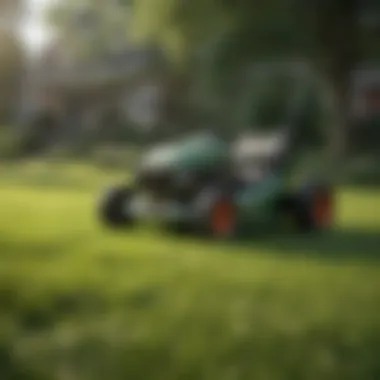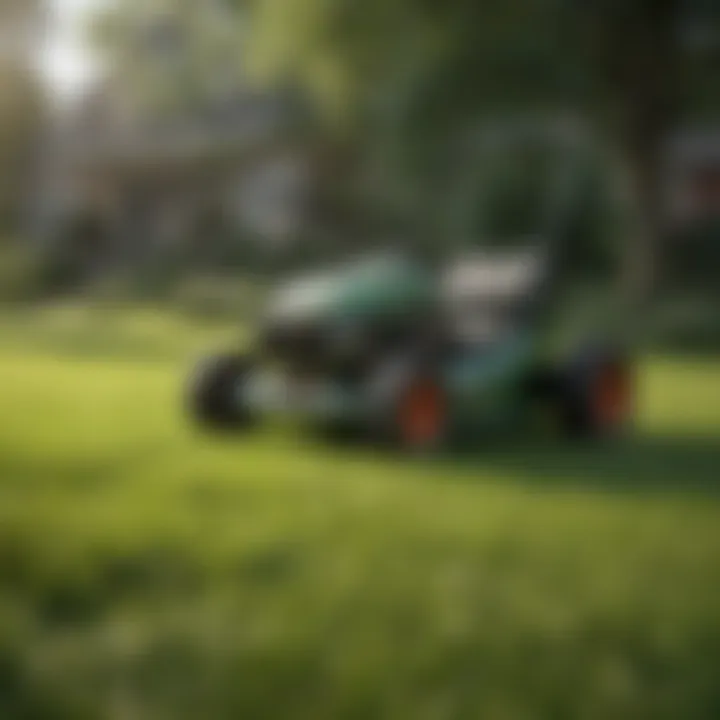A Comprehensive Guide to Aerating Your Lawn


Intro
Aerating a lawn is often an overlooked yet critical aspect of lawn care. It plays a significant role in maintaining a healthy and vibrant lawn. Understanding why and how to aerate can lead to greater satisfaction in home gardening. This article explores the myriad benefits of lawn aeration, examines the various methods available, and identifies key timings for undertakking this necessary task. Additionally, we will outline essential aftercare considerations and the tools required to achieve effective results.
Lawn aeration refers to the process of perforating the soil with holes, allowing air, water, and nutrients to penetrate deep into the root zone. This process encourages healthy grass growth and improves resilience against pests and diseases. Many homeowners may wonder about the techniques to use and the proper times for aeration. The key is to address these questions thoroughly to enable better lawn management.
Ultimately, this guide serves not just to inform but to empower homeowners. By grasping the significance of lawn aeration, individuals can improve both the health and appearance of their outdoor spaces. After all, a well-aerated lawn is more resilient, looks better, and provides a lush environment for enjoying outdoor activities.
Design Inspirations
While aeration itself may seem like a pragmatic task, the designs and aesthetics of a lawn remain equally important. A well-maintained lawn can enhance the overall appearance of a home. Thus, it is beneficial for homeowners to draw inspiration from trending styles and color palettes that can complement their outdoor spaces.
Trending Styles
In current landscaping trends, the focus is increasingly on sustainability and minimalism. Homeowners may consider incorporating natural elements like native plants into their lawns. This approach not only supports local biodiversity but also minimizes the need for heavy maintenance.
Popular styles also include clean lines, which provide a modern appearance. Using sharp borders to delineate different areas of a lawn can create a sophisticated look. Other trends like wildflower patches can add vibrant colors and support pollinators, balancing aesthetics with functionality.
Color Palettes
Optimal color choices for lawns can elevate outdoor spaces. Shades of green are essential, but incorporating other colors can create visual interest. Consider integrating seasonal flowers that bloom throughout the year to provide a dynamic palette.
Some popular color combinations for lawns include:
- Vivid greens with splashes of vibrant yellows
- Deep blues paired with white daisies
- Earthy browns and soft greens for a muted look
These choices enhance the beauty of the space while supporting a vibrant ecosystem.
Maintenance and Upkeep
To maintain a healthy lawn, post-aeration care is essential. This section discusses critical aspects of seasonal maintenance and gives tips for cleaning and organizing tools.
Seasonal Maintenance Checklist
- Early Spring: Fertilize and overseed the lawn for optimal growth. Aerate if not done in the previous fall.
- Mid-Spring: Monitor for pests and treat accordingly.
- Summer: Mow regularly and ensure adequate watering, especially during dry spells.
- Fall: Aerate again, along with overseeding, to prepare for winter.
By following this checklist, homeowners can ensure their lawns remain healthy throughout the year.
Cleaning and Organization Tips
Keeping tools in good condition is key for effective aeration and lawn care. Consider these tips:
- Store aerators and lawn care tools in a dry place.
- Clean tools after each use to remove soil and debris.
- Organize garden benches and sheds to ensure easy access to tools.
"An orderly space enhances efficiency and encourages regular maintenance routines."
By considering both aesthetics and maintenance, homeowners can create not just a garden but a vibrant outdoor environment that reflects their values and care for nature.
Understanding Lawn Aeration
Lawn aeration is a fundamental practice that significantly influences the overall health of your lawn. This process involves perforating the soil with holes to allow air, water, and nutrients to penetrate deep into the roots. By understanding the principle of lawn aeration, homeowners can enhance their lawn care strategies and achieve remarkable results in both appearance and durability of their grass.
Definition and Purpose
Aeration can be defined as the mechanical process of creating small holes in the soil. These holes enable essential elements to reach the roots more effectively. The primary purpose is to alleviate soil compaction, which can restrict root growth. Compact soil can lead to poor nutrient uptake and inadequate water infiltration. Therefore, aeration creates the necessary channels for roots to thrive, ultimately leading to a healthier lawn.
Importance of Aeration for Lawn Health
The significance of aeration extends beyond just improving physical access to water and nutrients. In simple terms, a well-aerated lawn aids in:
- Enhancing soil quality: By breaking up compacted soil, aeration improves the soil structure and creates a more favorable environment for microbial activity.
- Strengthening root systems: Adequate oxygen levels encourage stronger and deeper root growth, making grass more resilient to temperature fluctuations and drought.
- Boosting nutrient absorption: With improved penetration of fertilizers and organic matter, plants can absorb minerals effectively.
"Aeration is not just a chore; it is an investment in the long-term vitality of your lawn."
Given these points, understanding the practice of lawn aeration is crucial for any homeowner looking to maintain a lush and vibrant lawn.
Benefits of Aeration
Aeration is a crucial practice for maintaining a healthy lawn. It addresses several issues related to soil structure and overall lawn vitality. When done correctly, aeration leads to improved lawn health. The benefits are multifaceted and contribute to a more vibrant and robust lawn environment.
Enhanced Soil Aeration


Soil aeration is a primary benefit of the aeration process. Through aeration, soil structure is improved by creating small holes in the soil. This allows air to penetrate deeper into the ground. Consequently, roots receive more oxygen, which is vital for their growth and metabolism. This process helps break down compacted soil, leading to a healthier microbial ecosystem. The result is a lawn that is not only healthier but more resilient.
Improved Nutrient Absorption
When the soil is properly aerated, nutrient absorption significantly improves. The aeration process opens pathways for essential nutrients to reach the root zone more efficiently. This is especially crucial after fertilization, allowing nutrients to penetrate the soil effectively. Well-aerated lawns digest fertilizers more efficiently which promotes vibrant growth and enhances the lawn's overall appearance. Homeowners can see noticeable differences in their grass quality and color as nutrient levels stabilize.
Promoting Root Growth
Strong roots are essential for a robust lawn. Aeration promotes root growth by ensuring roots can expand beyond the surface. With better penetration of air, water, and nutrients, roots grow deeper and stronger. This allows grass to better withstand environmental stress, including droughts and temperature fluctuations. Over time, a lawn with deep roots will require less watering and perform better under challenging weather conditions.
Reducing Soil Compaction
Soil compaction is a common problem that many lawns face. It occurs when the soil particles are pressed together, reducing the space between them. This hinders water, air, and nutrients from reaching the roots. Aeration helps alleviate soil compaction. By creating holes, aerators allow the soil to regain its structure. Lawn aeration should be considered a regular maintenance practice. It ensures that soil remains loose enough to sustain healthy root systems.
Enhancing Water Infiltration
Water’s ability to infiltrate the soil directly impacts a lawn’s health. Compacted or poorly aerated soil often struggles to absorb rainfall or irrigation efficiently. Aeration improves water infiltration dramatically. The holes created during the process allow water to permeate the soil better, reducing runoff and promoting effective absorption. This leads to a more evenly hydrated lawn, preventing over-saturated areas and drought stress spots.
"Regular aeration leads to a dramatic improvement in lawn health, resilience, and aesthetic appeal."
By recognizing these benefits, homeowners can understand why aeration is an essential part of lawn care. With proper aeration, a lawn can thrive, offering a green and lush appearance throughout the seasons.
When to Aerate Your Lawn
Aeration is crucial for maintaining a healthy and vibrant lawn. To achieve the best results, timing is essential. Knowing when to aerate your lawn can impact the effectiveness of the process. It also plays a role in how well your lawn responds afterward. The right timing ensures maximum benefit and improves your long-term lawn care results.
Seasonal Considerations
The seasons significantly influence the aeration process. Generally, the best times to aerate are in the spring and fall. In the spring, after the last frost, the grass starts to grow actively. This growth encourages recovery after aeration. Alternatively, the fall is often preferred as temperatures are cooler. This season generally offers less stress on the lawn. The appropriate season varies based on your specific climate. For example, warm-season grasses thrive better with summer aeration. It is vital to consider the type of grass you have when selecting the season.
Soil and Lawn Condition
Examining your lawn and soil condition aids in determining the best time to aerate. A lawn exhibiting signs of stress may require immediate aeration. Look for compacted soil or areas where water pools. Such conditions indicate that aeration is necessary. If the lawn feels spongy or lacks resilience when walked on, it’s time to act.
Additionally, soil testing can provide valuable insights. Testing soil pH and nutrient levels will clarify the health of the lawn. If results show unhealthy soil conditions, addressing these issues through aeration can bring significant improvements.
Remember: Aerating at the wrong time can do more harm than good. Ensure you conduct regular assessments of your lawn condition to make informed decisions.
Methods of Aeration
Methods of aeration are crucial in maintaining a healthy lawn. Each method has its unique approach and set of benefits. Understanding different aeration techniques allows homeowners to select what best fits their lawn's needs. Proper aeration can enhance soil aeration and nutrient availability, improve drainage, and foster an environment for strong root development.
Core Aeration
Core aeration is a method that removes plugs or cores of soil from the lawn. This process can effectively reduce soil compaction and enhance water and nutrient absorption. When using a core aerator, it is essential to aerate at the right time, typically during the growing season for cool-season grasses or warm-season grasses.
This method requires special equipment, often available for rent or purchase. Core aeration can be labor-intensive, but the results justify the effort. The removed soil plugs decompose on the surface, providing nutrients back to the lawn. This creates an ideal environment for new grass growth and promotes stronger root systems.
Spike Aeration
Spike aeration involves perforating the soil with spikes, creating holes in the lawn. While this method is simpler than core aeration, it tends not to alleviate compaction as effectively. The process pushes soil down instead of removing it, which can lead to soil sealing if done excessively.
Spike aerators are generally easier to use and can be hand-held or tractor-driven. They are commonly recommended for light, occasional aeration. However, homeowners should be cautious with this method. It is not as beneficial for denser soils where deep aeration is necessary.
Liquid Aeration
Liquid aeration is a more recent technique that involves applying a liquid solution to the lawn. This solution penetrates the soil to break down compacted areas. Though somewhat more expensive than traditional methods, many opt for liquid aeration due to its convenience and ease of application.
Another advantage is that liquid aeration can be absorbed quickly, making it suitable for all types of grass. This method also often allows for the incorporation of additional nutrients with the application. For those seeking a less invasive approach, liquid aeration is an excellent option to consider.
In summary, the method of aeration you choose depends on multiple factors, including soil type, budget, and lawn health. Understanding each method's advantages and disadvantages allows for informed decisions and optimal lawn care practices.
Tools Required for Aeration
Aerating a lawn is a vital process that benefits its overall health and appearance. However, the successful execution of this task inherently relies on using the right tools. Selecting appropriate equipment can make a significant difference in the efficiency and effectiveness of aeration. Below, we will delve into various tools necessary for aeration, providing insights into their advantages and how they fit into your overall lawn care strategy.
Manual Aerators
Manual aerators are simple tools that can be very effective for smaller lawns. They come in different forms, including handheld models and broader drum-like devices. Using a manual aerator requires physical effort but can be rewarding. Here are several benefits and considerations concerning manual aerators:
- Cost-Effective: Generally, manual aerators are less expensive than motorized options. They provide an accessible entry point for homeowners interested in lawn care.
- Precision: These tools allow for careful control during aeration. It is easier to focus on specific areas that may need more attention than others.
- Compact Size: Manual aerators are easy to store and typically lightweight, making them ideal for smaller properties.
However, manual aerators do have limitations. For larger lawns, they can be labor-intensive and time-consuming, making it difficult to complete the task efficiently.


Motorized Aerators
Motorized aerators take lawn care to another level, offering more power and speed compared to manual options. These devices can be either walk-behind or ride-on, depending on the size and power you require. Considering motorized aerators provides valuable insight into their advantages:
- Efficiency: Motorized aerators cover larger areas quickly, making them suitable for extensive lawns. This efficiency means you can aerate more land in a shorter amount of time.
- Consistent Results: Being machinery, they tend to provide more uniform results. The depth and spacing of aeration holes are consistent across the lawn, enhancing overall benefits.
- Less Physical Exertion: Using a motorized aerator reduces physical strain compared to a manual model, especially helpful for larger properties or for those who may have limitations on physical activity.
The cost of motorized aerators can be higher, and storage may require more space. It is essential to evaluate whether the investment aligns with your lawn care needs.
DIY Aeration Solutions
For those who seek a more personalized approach to lawn aeration, creating your own DIY solutions can be appealing. These methods can be effective and resourceful, particularly if you are looking to save on equipment costs. Here are some common DIY aeration solutions:
- Using a Pitchfork or Garden Fork: You can manually aerate your lawn by using a pitchfork or a garden fork. Simply push the tines into the soil at regular intervals and remove small plugs of soil. This method can work for smaller lawns with less compaction.
- Weighted Shoes: Another practical DIY solution involves attaching weights to your regular shoes or buying specialized aeration shoes. Walking around your lawn while wearing these can create holes in the soil, although this method may not provide as thorough aeration as more advanced tools.
- Homemade Core Aerator: Some skilled homeowners build their own core aerator by attaching metal spikes to a board and strapping it onto their feet. This type of setup can be creative but requires a level of comfort with tools and crafting.
While DIY solutions are often cost-effective, they may not always deliver the same level of results as commercial aerators. Consider your lawn's specific needs when deciding on a DIY approach.
In summary, choosing the right tools for aeration is vital for achieving a healthy lawn. Manual tools offer economy and control, motorized options provide efficiency and ease, and DIY solutions present resourceful alternatives.
Understanding the strengths and limitations of each type of tool will guide you toward making an informed decision tailored to your lawn care requirements.
Step-by-Step Aeration Process
The aeration process is fundamental for maintaining a healthy and lush lawn. It involves several stages that aim to maximize soil quality and optimize nutrient absorption. By following a systematic approach, homeowners can ensure they achieve the best results from aeration. Each step serves specific purposes that contribute to the overall health of the lawn. This process not only enhances the effectiveness of the aeration but also lays the groundwork for successful lawn care in the future.
Preparing the Lawn
Before beginning the aeration, it is important to prepare the lawn adequately. First, assess the current condition of the lawn. Look for areas with significant wear and compaction. Mow the grass to a lower height, generally around two inches, to allow the aerators to penetrate the soil effectively. In addition, remove any debris such as sticks, stones, or leaves. Clearing these objects will prevent them from obstructing the aeration tools and ensure that all areas of the lawn receive adequate attention.
Furthermore, consider watering the lawn one or two days prior to aeration. A well-moistened soil is softer and easier to penetrate, thus enhancing the aeration process. Ensure that the soil is moist but not oversaturated, as excess water can lead to poor aeration results.
Executing the Aeration
Aerating the lawn requires precision and the right tools. For most homeowners, core aeration is recommended due to its effectiveness. This method involves removing small plugs of soil, allowing nutrients, water, and air to reach the grassroots. Begin by making passes across the lawn, ensuring minimal overlap.
It is essential to manage the direction of the passes. First, aerate in one direction and then change to a perpendicular direction. This alternating method increases the soil area that receives aeration. Make sure to adjust the aerator settings according to the specific condition of your lawn.
After aeration, leave the soil plugs on the lawn surface. They will break down over time, helping to restore nutrients back into the soil.
Aftercare Post-Aeration
After the aeration process, it is crucial to give the lawn time to recover. Start by ensuring proper watering - aim for deep watering to help the soil settle and support new root growth. Avoid watering too frequently, as this can lead to shallow roots.
In addition to proper watering, fertilization is also important after aeration. Applying a balanced fertilizer can provide the necessary nutrients that the lawn needs for recovery. Consider using a slow-release fertilizer to achieve continuous feeding throughout the growing season.
Lastly, restrict traffic on the lawn for several weeks. Limiting foot traffic will help the grass recover and promote healthy growth. By following these aftercare practices, homeowners can maximize the benefits of aeration and establish a lush, green lawn.
"Proper aeration is not just a momentary task; it is an investment in the long-term health of your lawn."
Implementing this step-by-step aeration process effectively will result in a lawn that is vibrant and well-nourished.
Common Mistakes to Avoid
Understanding what not to do is crucial in achieving a healthy lawn. While there are many effective aeration methods, avoiding common pitfalls can save time and resources. This section highlights two primary mistakes that homeowners encounter when aerating their lawns: timing and lawn maintenance.
Aerating at the Wrong Time
Timing plays an essential role in the effectiveness of lawn aeration. Aerating at inappropriate moments can cause more harm than good. For instance, aerating during the peak of summer can stress the grass, especially in warmer climates. Excess heat can lead to browning and further reducing the vitality of your lawn.
It's also important to consider your climate zone. For cool-season grasses, the best times to aerate are in early spring or early fall. On the other hand, warm-season grasses benefit from aeration in late spring or early summer. Homeowners must be attuned to the typical weather patterns in their region to make informed decisions.
"Understanding your lawn’s needs is key to successful aeration."
The grass should be actively growing when aeration occurs. It allows the lawn to recover quickly and utilize the benefits of aeration, such as improved nutrient absorption and root growth. Failure to aerate at the right time can result in an ineffective process that leads to wasted efforts.
Neglecting Lawn Maintenance
Ignoring regular lawn maintenance can undermine the positive effects of aeration. Essentially, aeration is a rejuvenation process. However, if the lawn has not been cared for, the benefits may not manifest fully. Homeowners need to keep up with mowing, watering, and fertilization patterns before and after aeration.
Keeping the lawn at an appropriate height promotes healthy soil and grass growth. Additionally, regular mowing reduces thatch accumulation, which can hinder aeration effectiveness. When thatch is too thick, it can prevent air and water from penetrating the soil.
After aeration, it is equally crucial to maintain proper watering practices. This helps in quick recovery of the grass. Without appropriate moisture, the soil may become compact again, negating the benefits of aeration. Furthermore, homeowners should also plan for post-aeration fertilization to support grass rejuvenation.


In summary, the process of aerating your lawn can lead to significant improvements in its health. However, avoiding mistakes like aerating at the wrong time and neglecting routine lawn care ensures you optimize the benefits of this practice. Proper planning, attention to detail, and timely maintenance can result in a flourishing and vibrant lawn.
Long-Term Lawn Care Strategies
Long-term lawn care strategies are essential for maintaining a vibrant and healthy lawn. These strategies go beyond one-time aeration and encompass ongoing practices that ensure the lawn thrives over the years. Implementing these strategies leads to sustainability and resilience against environmental stressors such as pests and diseases.
Soil Testing and Analysis
Soil testing and analysis is a foundational element in lawn care. It informs the homeowner about the nutrient levels in the soil and helps to identify deficiencies. By understanding the pH level and nutrient balance, appropriate amendments can be made to support grass growth.
Regular testing, ideally once a year, can help track changes and improve soil health over time. Homeowners often use simple soil test kits available at garden centers or send samples to local agricultural extension offices. The results guide in selecting suitable fertilizers and adjustments needed for optimal lawn growth.
Fertilization Techniques Post-Aeration
After aeration, fertilization becomes even more crucial. The holes created during aeration allow nutrients to penetrate the soil more effectively. A balanced fertilizer with the right ratio of nitrogen, phosphorus, and potassium supports new growth and recovery.
Several techniques can be applied:
- Granular Fertilizers: These can be spread evenly across the lawn for controlled release.
- Liquid Fertilizers: Easy to apply, these can also target specific areas that may need extra nutrients.
- Organic Fertilizers: Incorporating compost or natural products can improve soil structure over time.
Applying fertilizer post-aeration typically occurs within a week after the process, ensuring that the lawn utilizes the nutrients at the optimal time.
Irrigation Practices Following Aeration
Proper irrigation is vital after aeration. The lawn needs sufficient water to promote recovery and growth. Timing and quantity are important post-aeration.
Here are key practices:
- Initial Watering: Immediately after aeration, provide a deep watering to help the lawn settle and absorb nutrients.
- Regular Watering Schedule: Adjust the irrigation frequency based on the season and weather conditions. During hot months, more frequent watering may be necessary.
- Deep Watering: Instead of shallow, frequent watering, deep watering encourages the roots to grow deeper into the soil.
"Well-aerated soil paired with proper watering can significantly enhance grass quality, aiding in the overall health of the lawn."
In essence, long-term lawn care strategies are integral to sustaining a flourishing lawn. Incorporating soil testing, effective fertilization, and diligent irrigation promotes ongoing lawn health. This attentive approach allows homeowners to enjoy a thriving green space for years to come.
Economic Considerations of Aeration
When discussing lawn aeration, understanding the economic implications is crucial. Economic considerations of aeration not only inform homeowners about potential costs but also the returns on investment over time. These factors are essential to making informed decisions regarding lawn care practices.
Cost Analysis of Aeration Methods
The cost of aeration can vary significantly depending on the method chosen. Core aeration typically requires specialized equipment, leading to higher rental or hiring fees. Prices for professional core aeration services can range from $75 to $200 per session, influenced by factors such as lawn size and regional labor costs.
In contrast, spike aeration is generally less expensive. Manual spike aerators can be purchased for about $30 to $100, making them accessible for homeowners who prefer do-it-yourself projects. However, they provide less effective aeration compared to core aerators.
Liquid aeration, while often viewed as a cost-effective alternative, usually involves ongoing costs associated with the application of solutions. These solutions can range anywhere from $30 to $100 per application. Thus, while the initial outlay may be lower, potential cumulative costs should be taken into account.
Here is a brief overview of the methods:
- Core Aeration: Higher upfront costs, but effective.
- Spike Aeration: Lower cost, less effective.
- Liquid Aeration: Moderate cost, with ongoing maintenance expenses.
Cost-Benefit Analysis over Time
The long term benefits of regular aeration often outweigh the initial costs. Benefits manifest in improved lawn health, meaning homeowners may save money on landscaping and lawn repair in future years. Healthy grass reduces the need for fertilizers and pesticides, leading to additional savings.
A well-aerated lawn tends to absorb water better, lowering irrigation costs, especially in dryer environments. It also helps prevent soil compaction, which can save on the costs associated with soil amendments and reseeding.
The cumulative benefits can produce a substantial return on investment:
- Increased Lawn Longevity: A healthy lawn lasts longer.
- Cost Savings on Maintenance: Reduced need for fertilizers and repairs.
- Water Conservation: Better water retention saves on bills.
The financial planning of lawn aeration can lead to significant long-term savings while also promoting a healthier environment.
Closure and Recommendations
Understanding the significance of aerating a lawn is essential for homeowners looking to maintain a healthy and aesthetic space. This comprehensive guide highlights various elements regarding aeration and offers concrete recommendations to ensure lasting results.
Aeration allows air, water, and nutrients to penetrate compacted soil, facilitating a robust lawn environment. This article stresses the need for proper timing, the right methods, and available tools to successfully aerate. Moreover, the importance of post-aeration care cannot be overlooked. Implementing these strategies not only revives the grass but also sustains its vitality.
Summarizing Key Points
- Aeration's Role: Lawn aeration is vital for enhancing soil quality and health. It reduces compaction and promotes better air exchange.
- Optimal Timing: The timing of aeration can influence its effectiveness. It is best to aerate when the grass is actively growing.
- Methods Available: Various aeration techniques exist, such as core aeration and spike aeration, each with its benefits.
- Post-Care Matters: After aeration, proper watering and fertilization are key to maximizing benefits.
By understanding these points, homeowners can make informed decisions about lawn care.
Final Recommendations for Lawn Care
The recommendations below can help keep your lawn thriving after aeration:
- Follow Up with Fertilization: Applying a balanced fertilizer after aeration encourages new grass growth.
- Regular Watering: Ensure to water adequately post-aeration to aid in soil recovery and moisture retention.
- Monitor Lawn Health: Keep an eye on the lawn’s response to aeration and adjust care practices as needed.
- Seasonal Maintenance: Incorporate aeration into an annual lawn care routine, tailoring methods and timings based on specific lawn conditions.







